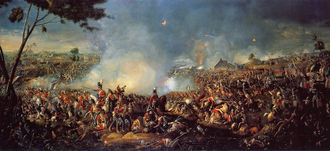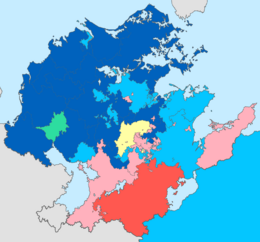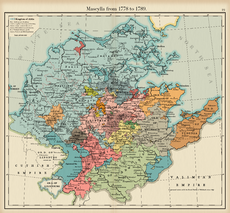War of the Five Kings: Difference between revisions
mNo edit summary |
mNo edit summary |
||
| (8 intermediate revisions by the same user not shown) | |||
| Line 10: | Line 10: | ||
* Dissolution of the [[Elbgau Confederation]] | * Dissolution of the [[Elbgau Confederation]] | ||
* Formation and unification of the [[Mascyllary Kingdom]] | * Formation and unification of the [[Mascyllary Kingdom]] | ||
* Exclusion of [[Kingdom of | * Exclusion of [[Kingdom of Adwinia|Adwinia]] from Mascyllary politics and leadership | ||
* Inherent rise of Mascylla as a Berean {{wp|great power}} | * Inherent rise of Mascylla as a Berean {{wp|great power}} | ||
| territory = | | territory = | ||
* Aldia annexes fringe possessions and parts of Holnia and | * Aldia annexes fringe possessions and parts of Holnia and Adwinia | ||
* Welsbach annexes parts of northern | * Welsbach annexes parts of northern Adwinia and [[Grand Duchy of Tudonia|Tudonia]] | ||
* Incorporation of all Mascyllary states into the Mascyllary Kingdom, excluding the Grand Duchy of Lingburg and Duchy of Lilienburg | * Incorporation of all Mascyllary states into the Mascyllary Kingdom, excluding the Grand Duchy of Lingburg and Duchy of Lilienburg | ||
| combatant1 = {{flagicon image|Elbgau_Confederacy_flag.png}} [[Elbgau Confederation]] | | combatant1 = {{flagicon image|Elbgau_Confederacy_flag.png}} [[Elbgau Confederation]] | ||
| Line 26: | Line 26: | ||
* Konreid | * Konreid | ||
* Gärlburg-Altenberg | * Gärlburg-Altenberg | ||
* Flussmund | * {{flagicon image|Flag_of_Hesse.svg}} Flussmund | ||
* Estmar | * {{flagicon image|Flagge_Wismar.svg}} Estmar | ||
* | * {{flagicon image|Drapeau_france_1848.svg}} | ||
* Dockfurt | * {{flagicon image|Flag_of_Bremen.svg}} Dockfurt | ||
'''Supported by:'''<br>{{flagicon image|Valimia-1700-1850.png}} [[Valimian Empire]] | '''Supported by:'''<br>{{flagicon image|Valimia-1700-1850.png}} [[Valimian Empire]]{{ref label|e|e}} | ||
| combatant2 = {{flagicon image|FlagAdwhin.png}} [[Kingdom of | | combatant2 = {{flagicon image|FlagAdwhin.png}} [[Kingdom of Adwinia|Adwinia]]<br>{{flagicon image|Flag_of_Bavaria_(striped).svg}} Holnia<br>{{flagicon image|Flagge_Großherzogtümer_Mecklenburg.svg}} [[Grand Duchy of Tudonia|Tudonia]]<br>{{flagicon image|Flag of the Grand Duchy of Amretz-Heinrichsbronn-Amsern.png}} Amretz-Heinrichsbronn-Amsern<br>{{flagicon image|Flag of the Duchy of Welsbach-Gehrach.png}} Welsbach-Gehrach<br>{{flagicon image|Flag of the Duchy of Engelbart-Maining und Saanberg.png}} Engelbart-Maining und Saalburg<br>{{flagicon image|Flag of the Principality of Würthburg.png}} Würthburg | ||
| commander1 = {{flagicon image|Aldia_flag.png}} [[Monarchy of Mascylla|Lucas I]]<br>{{flagicon image|Aldia_flag.png}} [[Prime Minister of Mascylla|William of Stenreck]]<br> {{flagicon image|Aldia_flag.png}} Helmuth of Mohrnau<br> {{flagicon image|Aldia_flag.png}} George of Schüldte<br>{{flagicon image|Flag of the Kingdom of Welsbach.png}} {{flagicon image|Valimia-1700-1850.png}} [[List of Valimian monarchs#Valimian Empire|Charles Frederick II]] | | commander1 = {{flagicon image|Aldia_flag.png}} [[Monarchy of Mascylla|Lucas I]]<br>{{flagicon image|Aldia_flag.png}} [[Prime Minister of Mascylla|William of Stenreck]]<br> {{flagicon image|Aldia_flag.png}} Helmuth of Mohrnau<br> {{flagicon image|Aldia_flag.png}} George of Schüldte<br>{{flagicon image|Flag of the Kingdom of Welsbach.png}} {{flagicon image|Valimia-1700-1850.png}} [[List of Valimian monarchs#Valimian Empire|Charles Frederick II]]{{ref label|f|f}}<br>Franz Kohlner<br>William of Oppenburg | ||
| commander2 = {{flagicon image|FlagAdwhin.png}} Charles Anthony III<br>{{flagicon image|FlagAdwhin.png}} Christopher of Wälsberg<br>{{flagicon image|FlagAdwhin.png}} Louis of Bernestedt<br>{{flagicon image|Flag of the Grand Duchy of Amretz-Heinrichsbronn-Amsern.png}} Erich Joseph Kleitzer<br>{{flagicon image|Flag_of_Bavaria_(striped).svg}} Crown Prince Leopold | | commander2 = {{flagicon image|FlagAdwhin.png}} Charles Anthony III<br>{{flagicon image|FlagAdwhin.png}} Christopher of Wälsberg<br>{{flagicon image|FlagAdwhin.png}} Louis of Bernestedt<br>{{flagicon image|Flag of the Grand Duchy of Amretz-Heinrichsbronn-Amsern.png}} Erich Joseph Kleitzer<br>{{flagicon image|Flag_of_Bavaria_(striped).svg}} Crown Prince Leopold | ||
| strength1 = '''666,370''' | | strength1 = '''666,370''' | ||
| Line 49: | Line 49: | ||
* {{flagicon image|Flag_of_Germany_(3-2_aspect_ratio).svg}} 12,496 | * {{flagicon image|Flag_of_Germany_(3-2_aspect_ratio).svg}} 12,496 | ||
}} | }} | ||
The '''War of the Five Kings''' ({{wp|German language|Hesurian}}: ''Krieg der fünf Könige''), also known as the '''Mascyllary War of Unification''' | The '''War of the Five Kings''' ({{wp|German language|Hesurian}}: ''Krieg der fünf Könige'' {{wp|Help:IPA/Standard German|[ˈkʁi:k de:ɐ̯ fʏnf kø:nɪgə]}}), also known as the '''Mascyllary War of Unification'''{{ref label|a|a}}, '''Third Aldo-Adwinian War'''{{ref label|b|b}}, '''Brothers War'''{{ref label|c|c}}, or in Mascylla the '''Mascyllary War'''{{ref label|d|d}}, was the last {{wp|war}} between the [[Kingdom of Aldia]] and [[Kingdom of Adwinia]] and their respective allies in the [[Elbgau Confederation]] and remaining Mascyllary states, and ultimately culminated in the Aldian-led unification of Mascylla into the [[Mascyllary Kingdom]] following the war's end with the Treaty of Langquaid in 1793. | ||
In March 1789, the | In March 1789, the [[Duchy of Phalia-Lehpold|Duke of Phalia-Lehpold]], [[Duchy of Phalia-Lehpold|Charles IV]], suddenly died but left no {{wp|heir apparent}} and the throne vacant. Aldia quickly suggested an [[House of Ahnern|Ahnern]] candidate, Lucas's brother [[Leopold, Grand Duke of Jusland|Leopold]], as Phalia's successor, but Adwinia, recognizing the strategic and economic importance of Phalya, aggressively objected and pushed for King Charles's nephew, Prince [[Maximilian, Duke of Sohlnar-Freying|Maximilian]], to succeed Charles IV. The issue quickly evolved into a diplomatic fiasco, and on 4 September 1789, Adwinia issued to resolve the conflict through war. | ||
While | While Adwinia quickly invaded Phalia, the Elbgau Confederation was able muster a larger standing army under the command of ''{{wp|Generalfeldmarschall}}'' [[Prime Minister of Mascylla#List of Prime Ministers (1793–present)|Wilhelm Fürst von Stenreck]]. The conflict quickly escalated into a full-scale war and it became apparent the Elbgau Confederacy and its allies would emerge victorious. After numerous victorious battles in Eustria and Phalia over the course of two years, the [[Battle of Auserburg]] in May 1790 was a decisive blow to the Adwinian armies protecting the fortress of Auserburg, completely eradicating the bulk of its land army and capturing King Theodore himself. While Aldia continued to advance further south, Franz Kohlner and a trail of thousands of petty soldiers, peasants and activists, collectively known as the "[[Expedition of the Thousand (Mascylla)|Expedition of the Thousand]]" (''Zug der Tausend'') and politically motivated by the [[Cuthish Revolution]], marched onto and invaded [[Breisgau]]. | ||
Shortly thereafter, | Shortly thereafter, Adwinia capitulated without any peace terms and representatives of 20 Mascyllary states and free cities gathered in the [[Congress of Lancaide]]. [[Kingdom of Aldia#List of Kings of Aldia|Lucas I]] of Aldia was chosen to ascend the title of [[Monarchy of Mascylla|Mascyllary King]] after the style of [[Monarchy of Mascylla|Emperor of Mascylla]] (''Maskillischer {{wp|Kaiser}}'') was unanimously rejected, the Elbgau Confederation was dissolved, and its member states as well as the defeated nations were merged into a single Mascyllary state. Rigorous debate ensued in response to Mascylla's formation as an {{wp|enlightened absolutism|Enlightened absolutist monarchy}}, as intellectuals had hoped to implement Cuthish revolutionary ideals. The [[Treaty of Lancaide (1793)|Treaty of Lancaide]] itself was signed and ratified on 18 May 1793 after months of negotiation. Subsequently, Lucas I was officially coronated in the St Michael's Cathedral in Lancaide to the largest audience of nobility in Mascyllary history. | ||
While the war itself was | While the war itself was brief, it left a devastating toll on the civilian population and southerly regions who suffered from {{wp|looting}} during the conflict. The government was largely composed of war veterans, such as Wilhelm Fürst von Stenreck, who was appointed Mascylla's first [[Prime Minister of Mascylla|Prime Minister]]. However, Adwinia and other southern states were deeply indebted, impoverished and virtually unrepresented politically, culminating in a [[Adwinian Peasents' Revolt of 1795|series of strikes and riots in 1795]] (''Aduhinischer Bauernaufstand'') which were quickly put down by Aldian military forces. | ||
However, Mascylla witnessed an unprecedented economic rise, and Lucas I massively grew in public popularity with the introduction of a new row of statutes that satisfied the expanding middle class of classical liberalists and nationalists who continued to rise in influence in national politics and commerce, while the country's {{wp|absolute monarchy|absolute monarchies}} were slowly replaced by {{wp|constitutional monarchy|constitutional}} systems. | |||
==Background== | ==Background== | ||
==Causes and opposing parties== | |||
==Course of the war== | |||
[[File:Map of the War of the Five Kings.png|260px|thumb|left|Sides and alliances of the War of the Five Kings:<br>{{colorbox|#0062BD}} [[Kingdom of Aldia]]<br>{{colorbox|#04C6FF}} Other [[Elbgau Confederation]] members and [[Valimian Empire]]<br>{{colorbox|#2DDDA0}} Neutral states (Birchau)<br>{{colorbox|#FFFEA5}} Disputed territory (Phalya)<br>{{colorbox|#FF5850}} [[Kingdom of Adwinia]]<br>{{colorbox|#FFB1BD}} Adwinian allies]] | |||
==Negotiations and aftermath== | ==Negotiations and aftermath== | ||
===Treaty of Langquaid=== | ===Treaty of Langquaid=== | ||
| Line 73: | Line 75: | ||
Ultimately, the treaty itself was signed and ratified on 18 May 1793 after months of negotiation. Lucas I was officially coronated in Langquaid to the largest audience of nobility in Mascylla's history on 23 May as "Mascyllary King" (''Maskillischer König''). | Ultimately, the treaty itself was signed and ratified on 18 May 1793 after months of negotiation. Lucas I was officially coronated in Langquaid to the largest audience of nobility in Mascylla's history on 23 May as "Mascyllary King" (''Maskillischer König''). | ||
===War aftermath=== | ===War aftermath and analysis=== | ||
===Problems=== | |||
===Subsequent events=== | |||
{{Template:History of Mascylla}} | {{Template:History of Mascylla}} | ||
==References== | ==References== | ||
==Notes== | |||
:a.{{note|a}} {{wp|German language|Hesurian}}: ''Maskillischer Einigungskrieg'', <small>IPA:</small> {{wp|Help:IPA/Standard German|[ˈmaski:lɪʃɐ ˈaɪ̯nɪgʊŋskʁi:k]}} | |||
:b.{{note|b}} {{wp|German language|Hesurian}}: ''Dritter Aldisch-Aduhinischer Krieg'', <small>IPA:</small> {{wp|Help:IPA/Standard German|[ˈdʁɪtɐ aldɪʃˈa:dʊhɪnɪʃɐ kʁi:k]}} | |||
:c.{{note|c}} {{wp|German language|Hesurian}}: ''Brüderkrieg'', <small>IPA:</small> {{wp|Help:IPA/Standard German|[ˈbʁy:dɐkʁi:k]}} | |||
:d.{{note|d}} {{wp|German language|Hesurian}}: ''Maskillischer Krieg'', <small>IPA:</small> {{wp|Help:IPA/Standard German|[ˈmaski:lɪʃɐ ˈkʁi:k]}} | |||
:e.{{note|e}} The [[Valimian Empire]] and Grand Duchy of Welsbach were jointly ruled through the Welsbach–Valimia {{wp|personal union}} from 1659 to 1923. | |||
:f.{{note|f}} Simultaneous Grand Duke of Welsbach and Emperor of Valimia since 1763. | |||
[[Category:Mascylla]][[Category:History of Aurorum]][[Category:History of Mascylla]] | [[Category:Mascylla]][[Category:History of Aurorum]][[Category:History of Mascylla]] | ||
Latest revision as of 20:03, 16 January 2023
This article is incomplete because it is pending further input from participants, or it is a work-in-progress by one author. Please comment on this article's talk page to share your input, comments and questions. Note: To contribute to this article, you may need to seek help from the author(s) of this page. |
| War of the Five Kings | |||||||||
|---|---|---|---|---|---|---|---|---|---|
 The Battle of Auserburg (7-8 May 1790) | |||||||||
| |||||||||
| Belligerents | |||||||||
|
| ||||||||
| Commanders and leaders | |||||||||
|
Franz Kohlner William of Oppenburg |
| ||||||||
| Strength | |||||||||
|
666,370
|
556,700
| ||||||||
| Casualties and losses | |||||||||
|
61,205
|
102,320
| ||||||||
The War of the Five Kings (Hesurian: Krieg der fünf Könige [ˈkʁi:k de:ɐ̯ fʏnf kø:nɪgə]), also known as the Mascyllary War of Unification[a], Third Aldo-Adwinian War[b], Brothers War[c], or in Mascylla the Mascyllary War[d], was the last war between the Kingdom of Aldia and Kingdom of Adwinia and their respective allies in the Elbgau Confederation and remaining Mascyllary states, and ultimately culminated in the Aldian-led unification of Mascylla into the Mascyllary Kingdom following the war's end with the Treaty of Langquaid in 1793.
In March 1789, the Duke of Phalia-Lehpold, Charles IV, suddenly died but left no heir apparent and the throne vacant. Aldia quickly suggested an Ahnern candidate, Lucas's brother Leopold, as Phalia's successor, but Adwinia, recognizing the strategic and economic importance of Phalya, aggressively objected and pushed for King Charles's nephew, Prince Maximilian, to succeed Charles IV. The issue quickly evolved into a diplomatic fiasco, and on 4 September 1789, Adwinia issued to resolve the conflict through war.
While Adwinia quickly invaded Phalia, the Elbgau Confederation was able muster a larger standing army under the command of Generalfeldmarschall Wilhelm Fürst von Stenreck. The conflict quickly escalated into a full-scale war and it became apparent the Elbgau Confederacy and its allies would emerge victorious. After numerous victorious battles in Eustria and Phalia over the course of two years, the Battle of Auserburg in May 1790 was a decisive blow to the Adwinian armies protecting the fortress of Auserburg, completely eradicating the bulk of its land army and capturing King Theodore himself. While Aldia continued to advance further south, Franz Kohlner and a trail of thousands of petty soldiers, peasants and activists, collectively known as the "Expedition of the Thousand" (Zug der Tausend) and politically motivated by the Cuthish Revolution, marched onto and invaded Breisgau.
Shortly thereafter, Adwinia capitulated without any peace terms and representatives of 20 Mascyllary states and free cities gathered in the Congress of Lancaide. Lucas I of Aldia was chosen to ascend the title of Mascyllary King after the style of Emperor of Mascylla (Maskillischer Kaiser) was unanimously rejected, the Elbgau Confederation was dissolved, and its member states as well as the defeated nations were merged into a single Mascyllary state. Rigorous debate ensued in response to Mascylla's formation as an Enlightened absolutist monarchy, as intellectuals had hoped to implement Cuthish revolutionary ideals. The Treaty of Lancaide itself was signed and ratified on 18 May 1793 after months of negotiation. Subsequently, Lucas I was officially coronated in the St Michael's Cathedral in Lancaide to the largest audience of nobility in Mascyllary history.
While the war itself was brief, it left a devastating toll on the civilian population and southerly regions who suffered from looting during the conflict. The government was largely composed of war veterans, such as Wilhelm Fürst von Stenreck, who was appointed Mascylla's first Prime Minister. However, Adwinia and other southern states were deeply indebted, impoverished and virtually unrepresented politically, culminating in a series of strikes and riots in 1795 (Aduhinischer Bauernaufstand) which were quickly put down by Aldian military forces.
However, Mascylla witnessed an unprecedented economic rise, and Lucas I massively grew in public popularity with the introduction of a new row of statutes that satisfied the expanding middle class of classical liberalists and nationalists who continued to rise in influence in national politics and commerce, while the country's absolute monarchies were slowly replaced by constitutional systems.
Background
Causes and opposing parties
Course of the war

Kingdom of Aldia
Other Elbgau Confederation members and Valimian Empire
Neutral states (Birchau)
Disputed territory (Phalya)
Kingdom of Adwinia
Adwinian allies
Negotiations and aftermath
Treaty of Langquaid
A rigorous debate erupted as to how the political system of Mascylla would actually be structured; a majority of states from the south who had a conservative point of view advocated for an enlightened, but absolute monarchy, while the peasantry, middle class and a number of northern states favored a democratic republic with a monarch as its figure head. Fearing the southern states would rebel and eventually secede from Mascylla, Lucas I drafted a compromise betweeen both parties, in which the monarch would have considerable power but be advised and kept in check by elected members of government. While this compromise resolved the ongoing dispute of Mascylla's governance, Lucas had own personal aspirations as a leader of power and therefore detested being removed political powers. Franz Kohlner as an influential political figure first strongly opposed his proposal, but reluctantly agreed later on, burying the nation-wide hopes of a civil state spurred by rising discontent in the Cuthish Empire and Falland in the 1790s for another century.
Another similar discussion arose after Lucas I proposed the title of "Emperor of Mascylla" (Kaiser Maskilliens) to Stenreck and his war cabinet who had voiced interest in the proclamation of an empire following Mascylla's unification in 1792. However, the absolute majority of the nobility outright refused this royal institution, mainly because of the vocal superiority and higher ranking of the title of emperor in comparison to those of kings or grand dukes which Lucas acknowledged would have irrefutably endangered the integrity of Mascylla's unity and aliented him from his "subordinates" of other royal heads. Furthermore, the existance and continuation of the Welsbach–Valimia personal union under then-respective Grand Duke and Emperor Charles Frederick II would have meant that Lucas I as Emperor of Mascylla would outrank Charles Frederick II as Emperor of Valimia, and Charles, as member of the Imperial Convention, electing any Mascyllary emperor was seen as offensive and politically ridiculed.
Ultimately, the treaty itself was signed and ratified on 18 May 1793 after months of negotiation. Lucas I was officially coronated in Langquaid to the largest audience of nobility in Mascylla's history on 23 May as "Mascyllary King" (Maskillischer König).
War aftermath and analysis
Problems
Subsequent events
Part of a series on the |
|---|
| History of Mascylla |
 |
|
|
References
Notes
- a.^ Hesurian: Maskillischer Einigungskrieg, IPA: [ˈmaski:lɪʃɐ ˈaɪ̯nɪgʊŋskʁi:k]
- b.^ Hesurian: Dritter Aldisch-Aduhinischer Krieg, IPA: [ˈdʁɪtɐ aldɪʃˈa:dʊhɪnɪʃɐ kʁi:k]
- c.^ Hesurian: Brüderkrieg, IPA: [ˈbʁy:dɐkʁi:k]
- d.^ Hesurian: Maskillischer Krieg, IPA: [ˈmaski:lɪʃɐ ˈkʁi:k]
- e.^ The Valimian Empire and Grand Duchy of Welsbach were jointly ruled through the Welsbach–Valimia personal union from 1659 to 1923.
- f.^ Simultaneous Grand Duke of Welsbach and Emperor of Valimia since 1763.
